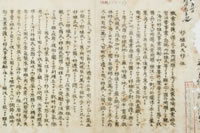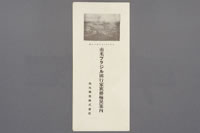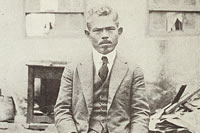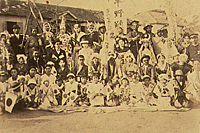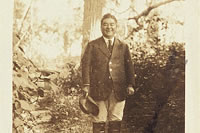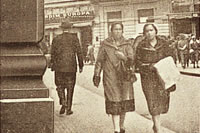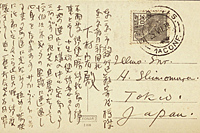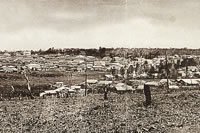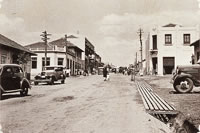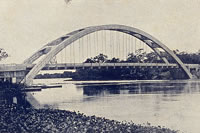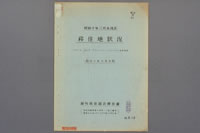Emigration incentives as a means of solving population and unemployment problems
Travel Grans for emigrants from the Home Ministry
In August 1922, the Home Ministry set forth draft measures, as a means of solving domestic population and unemployment problems, to promote emigration to the State of São Paulo by issuing subsidies to the private company engaged in emigration business (the Kaigai Kogyo Kabushiki Gaisha (Overseas Enterprise Company Limited)) which subsidies should be used to spread knowledge of emigration and settlement projects, install health and educational facilities in settlements and provide emigrants with grants for a voyage, home construction and living expenses.
The Ministry of Foreign Affairs in charge of supervising emigration business was strongly opposed to the travel grants for emigrants in particular, claiming that the grants would not have any effect on increase in the number of emigrants but have a negative impact on foreign relations. For these reasons, no travel grants were provided for emigrants in 1923 and the Government paid, in place of emigrants, voyage commissions alone (35 yen per adult emigrant) which emigrants had paid to the Kaigai Kogyo Kabushiki Gaisha (Overseas Enterprise Company Limited) for themselves before then.
But when the Government began to provide a grant of 200 yen per emigrant of 12 years of age and older (20,000 per 100 emigrants) from February 1924 as a provisional measure aimed at encouraging those who had suffered from the Great Kanto Earthquake to emigrate to South America, many of those applied. The Home Ministry, based on these results considering that the provision of a grant for emigrants might be effective for promoting emigration, submitted a supplementary budget, including an appropriation of 620,000 yen for the entire travel expenses of 3,000 emigrants, in July 1924, which was approved during the 49th Imperial Diet, Afterwards the amount appropriated was raised for 5,000 emigrants in 1926 and for 7,750 emigrants in 1927.
Rapid increase in Japanese emigrants
The commencement of the provision of emigrant travel grants resulted in a rapid increase in the number of emigrants. In 1930, the Revolution led by Getúlio Vargas broke out and in December, the Provisional Government enacted the "Foreign Immigration Restriction and Support for the Unemployed Law" which restricted the entry of immigrants for non-agricultural purposes. This restriction, however, did not apply to Japanese immigrants who were all treated as agricultural immigrants, and consequently Japanese immigrants were by far the most. Between 12,000 and 27,000 Japanese immigrants a year made a voyage with entry permit.
-
 Emigration incentive measures by the Home Ministry
Emigration incentive measures by the Home Ministry -
Original materials
Inspection report on Brazil by a government officer of the Home Ministry
-
 Kaigai Kogyo Kabushiki Gaisha (Oversea Enterprise Company Limited) pamphlet
Kaigai Kogyo Kabushiki Gaisha (Oversea Enterprise Company Limited) pamphlet
-
Articles in newspapers / magazines
-
 Saku Miura, president of the Nippaku Newspaper Company which published a weekly Japanese language paper in São Paulo City
Saku Miura, president of the Nippaku Newspaper Company which published a weekly Japanese language paper in São Paulo City -
 Fancy dress party in the Hirano Colony (Photographed 1938)
Fancy dress party in the Hirano Colony (Photographed 1938)
Overseas Emigration Association Act created and the Sociedade Colonizadora do Brazil Limitada (Brazilian Colonization Company) established
Discussions in the Imperial Economic Council
Consulted with the Imperial Economic Council which was an advisory council held in April -June 1924 under the chairmanship of Prime Minister Keigo Kiyoura to propose comprehensive economic policies, was what measures could be taken to promote emigration as a means of solving the problem of the population growing by 700 thousand people each year (Request for advice, No. 8). The council reached a conclusion that while emigration did not have much of an effect on the population problem, there were no better alternatives and that because emigration to the United States was no longer possible, Brazil was the best available destination for overseas emigration and that a company should be immediately established with government funding in order to purchase land in Brazil.
Overseas Emigration Cooperatives Act created
Meanwhile, the Shinano Kaigai Kyokai (Shinano Overseas Society) referred to in the Chapter 3, which had built the Alianca Settlement, had a plan to form an emigrant cooperative in accordance with the Industrial Cooperatives Act, to offer loans to emigrants so that they could purchase their own land. As it was found that the said act did not apply to overseas emigration projects, however, the society instead sought an enactment of the new law. As such, starting in 1924, Representative Naotake Tsuzaki introduced a "proposition on the establishment of emigrant cooperatives" and a "bill on emigrant cooperatives", and the Government (both the Home Ministry and the Ministry of Foreign Affairs) which had been critical of such bills until 1927, abruptly changed their stance and introduced a similar "Overseas Emigration Cooperatives Bill". The Overseas Emigration Cooperatives Act was created on March 30, based on the Government bill.
After the act came into force, overseas emigrant cooperatives in several prefectures planned projects to establish their own settlements in Brazil and offer loans to cooperative members and their families for the purchase of land and the settlement in the land. Emigration upon these projects emigration cooperatives planned was referred to as "Setting up business emigration", which meant emigration aimed at setting up a business (specifically running a farm).
Land purchases by executive director Mitsusada Umetani
In July 1927, the 4 prefectures of Okayama, Yamaguchi, Hiroshima and Mie established overseas emigration cooperatives and on August 1, the Federation of Overseas Emigrant Cooperatives was established. Afterwards, cooperatives were established in each prefecture one after another, and 13 prefectures established cooperatives in both 1927 and 1928.
In December 1927, Mitsusada Umetani (former Governor of Nagano Prefecture), executive director of the Federation, came to Brazil in order to purchase land for the construction of settlements. After exploring and selecting land, between June and November 1928, Umetani acquired land in Bastos (12,000 acres), Nova Alianca (1,327 acres), Tiete (the former name of Pereira Barreto, 46,687 acres) and Tres Barras in Parana (the former name of Assai, 12 500 acres).
At the same time, the existing Alianca colony of the Shinano Kaigai Kyokai (Shinano Overseas Society), the Tottori Ken Kaigai Kyokai (Tottori Prefecture Overseas Association) and the Toyama Ken Kaigai Imin Kyokai (Toyama Prefecture Overseas Emigration Association) as well as the existing Vila Nova of the Kumamoto Ken Kaigai Kyokai (Kumamoto Prefecture Overseas Association) was transferred under administration of the newly established overseas emigration cooperatives of each prefecture with funds which the Government loaned through the Federation of Overseas Emigrant Cooperative to the cooperatives.
From the principle of separate management by individual prefectures to the settlement principle of mixing Japanese and foreigner migrants
When Umetani, executive director of the Federation, visited Brazil to purchase land, he met with strong opposition to the Federation’s principle that each prefecture should manage its own settlement separately, that is, under control of the governmental organization (the Federation of Overseas Emigration Cooperatives) headed by the Home Minister, the organizations of each prefecture (overseas emigration cooperatives) should build their own settlement and ship emigrants there only from their own prefecture.
Since this principle would inevitably arouse anti-Japanese sentiment among Brazilians, which might cause exclusion of Japanese, the opponents argued that not only immigrants from their prefectures but also Brazilian natives and other Japanese migrants already in Brazil should be allowed to settle in the settlements (the settlement principle that Japanese and foreigner migrants should be mixed).
Accepting this argument, Umetani together with Ambassador in Brazil, Akira Ariyoshi and Consul General in São Paulo, Sukeyuki Akamatsu solicited the Ministry of Foreign Affairs for changes in the principle. But the solicitation was denied because (1) the project had been carried out by the Home Ministry in consultation with the Ministry of Foreign Affairs, and (2) the land for the settlements was bought collectively by the prefectural cooperatives, and (3) the entire project was elaborated based on the premise that settlements should be managed individually by the prefectures. It was not until discussions were held at several meetings between the Federation and the Home Ministry, Ministry of Foreign Affairs and representatives of each cooperative after Umetani returned to Japan in October 1928, and consequently the interested parties reached an understanding that this problem was settled. On January 16, 1929 the principle was changed at the extraordinary general meeting of the Federation.
Establishment of Brataku
With the change in the principle, the Sociedade Colonizadora do Brazil Limitada (Brazilian Colonization Company Limited, abbreviated as "Brataku" from its Japanese name "Burajiru Takushoku Kumiai"") was created in accordance with Brazilian law as a local agent in Brazil and began operations on April 1, 1929. In addition to land acquisition, Brataku also carried out activities that contributed to the independence and welfare of immigrants, including sales of land in lots to new immigrants from Japan and Japanese immigrants already in Brazil, construction of settlement roads, bridges, schools and hospitals, construction of agricultural products factories and production capital loans.
According to a Japanese language newspaper of São Paulo, Brataku, the Consulate General in São Paulo and the Kaigai Kogyo Kabushiki Gaisha (Overseas Enterprise Company Limited) were considered as the 3 major organizations providing the Japanese community in Brazil with guidance and leadership.
Recruitment and settlement of independent farmers
The conditions for the sales of settlement in lots by the Federation of Overseas Emigration Cooperatives to migrants were that a settler should purchase 25 or more hectares land for approximately 50 yen per 1ha of a prime land, without interest for 10 years. Those resident in any of the prefectures which had formed a cooperative, only have to join the cooperative to settle in its settlement. Those resident in any of the prefectures which had not yet formed a cooperative could joint a cooperative if they transferred their domicile to or set up a temporary residence in any of the prefectures which had a cooperative. Because settlers had to prepare quite a bit of money to reclaim and maintain life after the voyage until the next harvest, however, there were few emigrant applicants during the depression.
Immigrants came directly from Japan to the Bastos and Tiete Settlements from 1929 onwards, many of those immigrant who came directly from Japan and who were not yet used to lifestyles and culture in Brazil, however, were always complaining, so only those already resident in Brazil were permitted to settle in the Tres Barras Settlement where settlement began in 1932.
Bastos Settlement
In the Bastos Settlement, after settlers settled there, it was found that its soil was composed primarily of sandy soil and was very infertile, which caused setters to face hardships. Initially, it was planned to cultivate coffee in the settlement, coffee, however, suffered from frost damage in 1931 and 1932, and a prohibition order on the planting of new coffee was issued in November 1932, as a result settlers had no choice but to switch to the cultivation of cotton. Cotton brought prosperity at one time, but after the outbreak of the Pacific War, cotton export to Japan stopped, and then the settlement switched to silk farming again. Many settlers left the Bastos Settlement after the war because of silk prices drop and a severe decline in soil productivity.
Nevertheless, today the Bastos, Tiete (the former name of Pereira Barreto), Tres Barras (the former name of Assai) and Alianca Settlements still have a large population of Nikkei (people of Japanese descent).
Brataku Bank
When the settlement project was finally on track in 1937, Brataku established banking, commerce and other sections inside its organization, and the Brataku Bank (in August 1937) and Brataku textiles (in September 1940) under its umbrella. The Brataku Bank was launched as a financial institution under a personal account of Yoshiyuki Kato of Brataku, with 4 original branches opened in Bastos, Tiete, Aracatuba and Marilia Japanese settlements in outer regions of the State of São Paulo, and increased the number of branches every year. The bank increased its capital in October 1940 and then reorganized as the Nanbei Ginko (Bank of South America). The Nanbei Ginko (Bank of South America) grew as the bank of the Japanese community in Brazil after the war.
Casa Tozan
During the same period, with funds provided by private companies, the Nomura Nanbei Nojo (Nomura South America Farm), an overseas division of the Nomura Gomei Kaisha (Nomura Partnership Company) was established in 1926 (in the State of Parana) and the Casa Tozan (an overseas affiliate in Brazil of the Tozan Noji Kabushigaisha (Tozan Agricultural Company Limited). "Tozan" was a pen name of the Mitsubishi founder, Yataro Iwasaki.), belonging to the Mitsubishi Group, was established in 1927. Casa Tozan had business affairs, real estate, industrial, agricultural affairs, banking and general affairs sections, and the agricultural affairs section operated the Campinas and Pinda Farms in the State of São Paulo. The farms employed mainly Brazilian laborers rather than Japanese immigrants.
-
Books
-
 Imperial Economic Council advisory opinion
Imperial Economic Council advisory opinion -
Official publications
-
Books
Details of land purchases by executive director, Mitsusada Umetani
-
 Mitsusada Umetani
Mitsusada Umetani -
Articles in newspapers / magazines
-
 Exchanges between the Japanese Embassy and the Consulate in Brazil and the Ministry of Foreign Affairs regarding overseas emigration cooperatives principles
Exchanges between the Japanese Embassy and the Consulate in Brazil and the Ministry of Foreign Affairs regarding overseas emigration cooperatives principles -
 Details of a policy change from the principle of separate management by each prefecture to the principle of mixing Japanese and foreigner migrants
Details of a policy change from the principle of separate management by each prefecture to the principle of mixing Japanese and foreigner migrants -
 Brazilian Colonization Company Limited (Brataku) office (front side, third floor)
Brazilian Colonization Company Limited (Brataku) office (front side, third floor) -
 Letters from Mitsusada Umetani
Letters from Mitsusada Umetani -
 Federation of Overseas Emigrant Cooperatives pamphlet
Federation of Overseas Emigrant Cooperatives pamphlet -
 Whole view of Bastos City (October 1937)
Whole view of Bastos City (October 1937)

